- GM has shifted its focus from robotaxis to advanced driver-assistance technologies, capitalizing on high-margin opportunities presented by its Super Cruise system.
- This strategic pivot is driven by immediate profitability, with 20% of approximately 18,000 Super Cruise trial users opting for continued subscriptions.
- GM projects significant revenue growth, targeting $2 billion annually from smart technology by 2025.
- With the rise of innovative features in the auto industry, GM’s Super Cruise must evolve to remain competitive and avoid obsolescence.
- The shift exemplifies GM’s strategic adaptability, emphasizing a balance between current profitability and future innovation.
Once hailed as a revolution in transportation, GM’s robotaxi dreams have faded, leaving room for a more immediate, tangible vision: advanced driver-assist technologies. In a bold pivot, the renowned auto giant has reshaped its strategy, capitalizing on the burgeoning demand for high-tech driving innovations.
Imagine sleek roads filled with GM vehicles, almost sentient in their assistance. This vision is increasingly real, thanks to GM’s decision to double down on its Super Cruise technology. Instead of chasing the elusive, futuristic dream of autonomous taxis, GM has chosen a pragmatic path, one that yields high-margin profits today.
As 2024 drew to a close, GM revealed its intentions. Data shows that their timely shift to driver-assist technologies, embodied by Super Cruise, is not just a detour but a fast lane to profitability. Out of approximately 18,000 clients offered Super Cruise, a surprising 20% chose to continue subscriptions after the initial trial, illustrating a strong consumer appetite.
With around 33,000 vehicles poised to conclude trials in 2025, GM anticipates a revenue surge, aiming for a staggering $2 billion annually from this smart technology. Amidst an industry dominated by razor-thin margins, these high-margin tech solutions are a goldmine.
However, GM’s journey is not without its race against the clock. The auto industry is relentless, with innovative features quickly becoming standard expectations. Super Cruise, a Level 2 system reliant on human operation, may need to evolve swiftly to avoid obsolescence.
For GM, the pivot is a testament to strategic foresight, turning potential setbacks into lucrative opportunities. As the winds of technological change blow fiercely, GM’s adaptive strategies anchor its reputation as a stalwart in the automotive realm. Their decision to eschew the impractical for the profitable not only positions them as a leader but underscores a pivotal lesson: innovation is about tomorrow, but profitability is about today.
This Simple Strategy is GM’s Secret to Dominating the Auto Industry – Here’s How
Advanced Driver-Assist Technologies: GM’s Strategic Pivot
As transportation technology evolves, General Motors (GM) has made a strategic shift from the once-promising but elusive vision of robotaxis to a more tangible and immediate focus on advanced driver-assist technologies, particularly their Super Cruise system. Recognizing the potential for immediate profitability and consumer demand, GM has zeroed in on enhancing driver experience through technologies that bridge the gap between manual and fully autonomous driving.
How-To Steps & Life Hacks
For GM vehicle owners considering Super Cruise, here’s a simple guide to make the most out of the technology:
1. Subscription Activation: Super Cruise typically comes with a free trial. To activate it, ensure your vehicle is equipped with the necessary hardware and subscribe via the GM website or dealership.
2. Regular Updates: Keep the system updated with the latest software to ensure new features and improved performance.
3. Optimal Conditions: Use Super Cruise on highways and well-marked roads for the best experience. The system relies on lane markings for navigation.
4. Driver Readiness: Always stay alert and ready to take control. While Super Cruise allows hands-free driving, it requires active monitoring.
Real-World Use Cases
Super Cruise is gaining traction for its applications in real-world scenarios:
– Long-Distance Travel: Drivers report reduced fatigue on interstate highways.
– Busy Urban Areas: Assists in maintaining lane discipline and reducing stress during rush hour.
Market Forecasts & Industry Trends
The driver-assist market is projected to reach $61.3 billion by 2030, highlighting rapid growth and consumer adoption (Source: Allied Market Research). As more automakers venture into advanced driver-assist technologies, we can expect features like Super Cruise to become essential in new vehicles.
Reviews & Comparisons
Super Cruise is often compared to Tesla’s Autopilot and Ford’s BlueCruise. While Tesla’s Autopilot is more widespread, Super Cruise is praised for its robust safety measures, such as eye-tracking technology that ensures drivers remain engaged.
Controversies & Limitations
While Super Cruise offers a level of convenience and safety, it does face limitations:
– Geographic Restrictions: Primarily functions on highways mapped in GM’s database.
– Weather Sensitivity: Performance can vary in adverse weather conditions like heavy rain or snow.
Features, Specs & Pricing
– Subscription Cost: Post-trial, Super Cruise requires a subscription, typically pricing around $25/month.
– Tech Specs: Includes advanced radar and high-resolution cameras, backed by GM’s proprietary mapping and sensor fusion technology.
Security & Sustainability
GM is committed to security, implementing comprehensive cybersecurity measures to protect against hacking. Sustainability efforts include enhancing the software to minimize energy consumption, aligning with GM’s broader sustainability goals.
Insights & Predictions
Experts predict that GM’s focus on driver-assist technologies will potentially lead to innovations like Level 3 autonomy within the next decade, further reducing driver input and enhancing convenience.
Pros & Cons Overview
Pros:
– Reduces driver fatigue on long drives.
– Enhances safety with real-time driver monitoring.
Cons:
– Limited to certain road types.
– Subscription cost post-trial can be a barrier.
Actionable Recommendations
1. Test Before You Buy: Make use of the free trial to assess Super Cruise features and benefits.
2. Stay Informed: Regularly check for software updates to improve performance and reliability.
3. Plan Drives: Use Super Cruise for long highway trips to reduce fatigue and enhance safety.
By staying informed and utilizing these tips, drivers can maximize their use of GM’s Super Cruise, aligning with GM’s strategic pivot to focus on profitable, consumer-focused technologies that meet today’s driving demands. For more information on GM and its innovations, visit their official site here.










